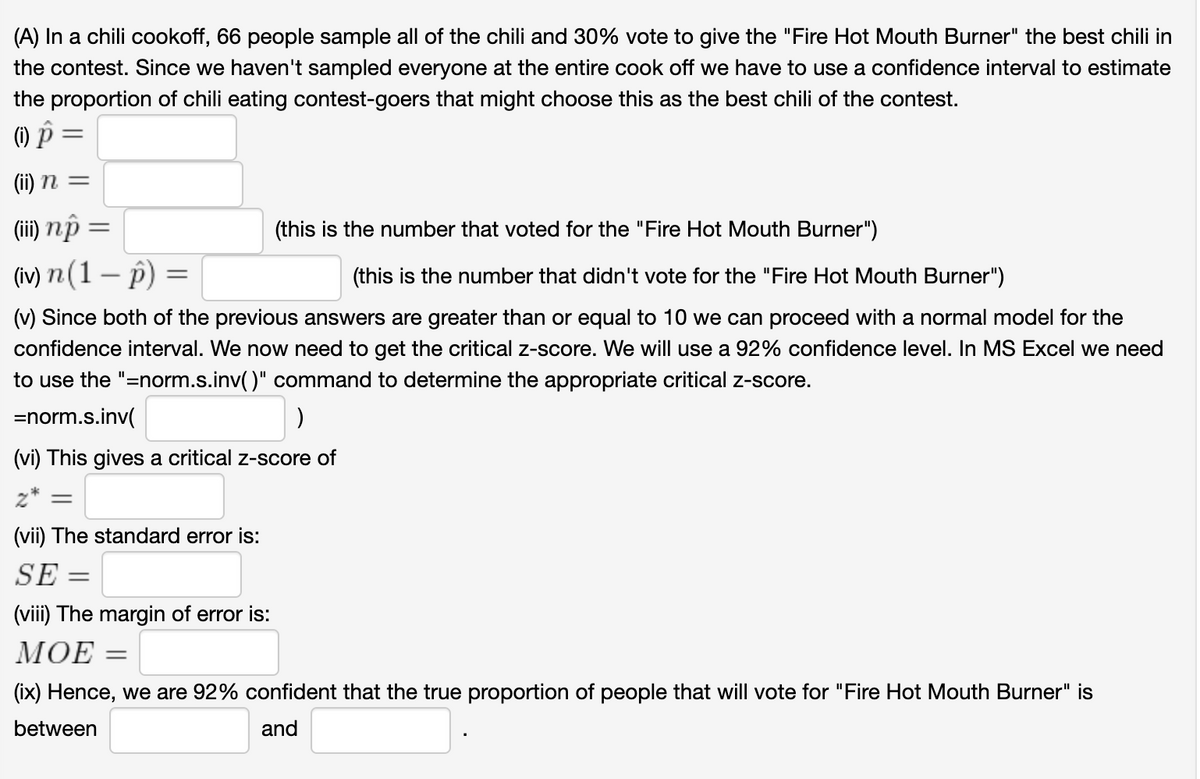(A) In a chili cookoff, 66 people sample all of the chili and 30% vote to give the "Fire Hot Mouth Burner" the best chili in the contest. Since we haven't sampled everyone at the entire cook off we have to use a confidence interval to estimate the proportion of chili eating contest-goers that might choose this as the best chili of the contest. () p = (ii) n = (ii) np = (iv) n (1 – p) = (this is the number that voted for the "Fire Hot Mouth Burner") (this is the number that didn't vote for the "Fire Hot Mouth Burner"") (v) Since both of the previous answers are greater than or equal to 10 we can proceed with a normal model for the confidence interval. We now need to get the critical z-score. We will use a 92% confidence level. In MS Excel we need to use the "=norm.s.inv()" command to determine the appropriate critical z-score. =norm.s.inv( (vi) This gives a critical z-score of (vii) The standard error is: SE = (viii) The margin of error is: МОЕ (ix) Hence, we are 92% confident that the true proportion of people that will vote for "Fire Hot Mouth Burner" is between and
(A) In a chili cookoff, 66 people sample all of the chili and 30% vote to give the "Fire Hot Mouth Burner" the best chili in the contest. Since we haven't sampled everyone at the entire cook off we have to use a confidence interval to estimate the proportion of chili eating contest-goers that might choose this as the best chili of the contest. () p = (ii) n = (ii) np = (iv) n (1 – p) = (this is the number that voted for the "Fire Hot Mouth Burner") (this is the number that didn't vote for the "Fire Hot Mouth Burner"") (v) Since both of the previous answers are greater than or equal to 10 we can proceed with a normal model for the confidence interval. We now need to get the critical z-score. We will use a 92% confidence level. In MS Excel we need to use the "=norm.s.inv()" command to determine the appropriate critical z-score. =norm.s.inv( (vi) This gives a critical z-score of (vii) The standard error is: SE = (viii) The margin of error is: МОЕ (ix) Hence, we are 92% confident that the true proportion of people that will vote for "Fire Hot Mouth Burner" is between and
MATLAB: An Introduction with Applications
6th Edition
ISBN:9781119256830
Author:Amos Gilat
Publisher:Amos Gilat
Chapter1: Starting With Matlab
Section: Chapter Questions
Problem 1P
Related questions
Question

Transcribed Image Text:(A) In a chili cookoff, 66 people sample all of the chili and 30% vote to give the "Fire Hot Mouth Burner" the best chili in
the contest. Since we haven't sampled everyone at the entire cook off we have to use a confidence interval to estimate
the proportion of chili eating contest-goers that might choose this as the best chili of the contest.
(1) P =
(ii) n =
(iii) np =
(this is the number that voted for the "Fire Hot Mouth Burner")
(iv) n(1 – p)
(this is the number that didn't vote for the "Fire Hot Mouth Burner")
(v) Since both of the previous answers are greater than or equal to 10 we can proceed with a normal model for the
confidence interval. We now need to get the critical z-score. We will use a 92% confidence level. In MS Excel we need
to use the "=norm.s.inv()" command to determine the appropriate critical z-score.
=norm.s.inv(
(vi) This gives a critical z-score of
z* =
(vii) The standard error is:
SE
(viii) The margin of error is:
MΟΕ
(ix) Hence, we are 92% confident that the true proportion of people that will vote for "Fire Hot Mouth Burner" is
between
and
Expert Solution
Step 1
Hey, since there are multiple subparts posted, we will answer first three subparts. If you want any specific subpart to be answered then please submit that subpart only or specify the subpart in your message.
- The sample proportion =0.3
Thus, the value of is 0.3
ii. The sample size n is 66
Thus, the value of n is 66.
iii. The value of n is given below;
Thus, the value of n is 19.8
Trending now
This is a popular solution!
Step by step
Solved in 2 steps

Knowledge Booster
Learn more about
Need a deep-dive on the concept behind this application? Look no further. Learn more about this topic, statistics and related others by exploring similar questions and additional content below.Recommended textbooks for you

MATLAB: An Introduction with Applications
Statistics
ISBN:
9781119256830
Author:
Amos Gilat
Publisher:
John Wiley & Sons Inc

Probability and Statistics for Engineering and th…
Statistics
ISBN:
9781305251809
Author:
Jay L. Devore
Publisher:
Cengage Learning

Statistics for The Behavioral Sciences (MindTap C…
Statistics
ISBN:
9781305504912
Author:
Frederick J Gravetter, Larry B. Wallnau
Publisher:
Cengage Learning

MATLAB: An Introduction with Applications
Statistics
ISBN:
9781119256830
Author:
Amos Gilat
Publisher:
John Wiley & Sons Inc

Probability and Statistics for Engineering and th…
Statistics
ISBN:
9781305251809
Author:
Jay L. Devore
Publisher:
Cengage Learning

Statistics for The Behavioral Sciences (MindTap C…
Statistics
ISBN:
9781305504912
Author:
Frederick J Gravetter, Larry B. Wallnau
Publisher:
Cengage Learning

Elementary Statistics: Picturing the World (7th E…
Statistics
ISBN:
9780134683416
Author:
Ron Larson, Betsy Farber
Publisher:
PEARSON

The Basic Practice of Statistics
Statistics
ISBN:
9781319042578
Author:
David S. Moore, William I. Notz, Michael A. Fligner
Publisher:
W. H. Freeman

Introduction to the Practice of Statistics
Statistics
ISBN:
9781319013387
Author:
David S. Moore, George P. McCabe, Bruce A. Craig
Publisher:
W. H. Freeman